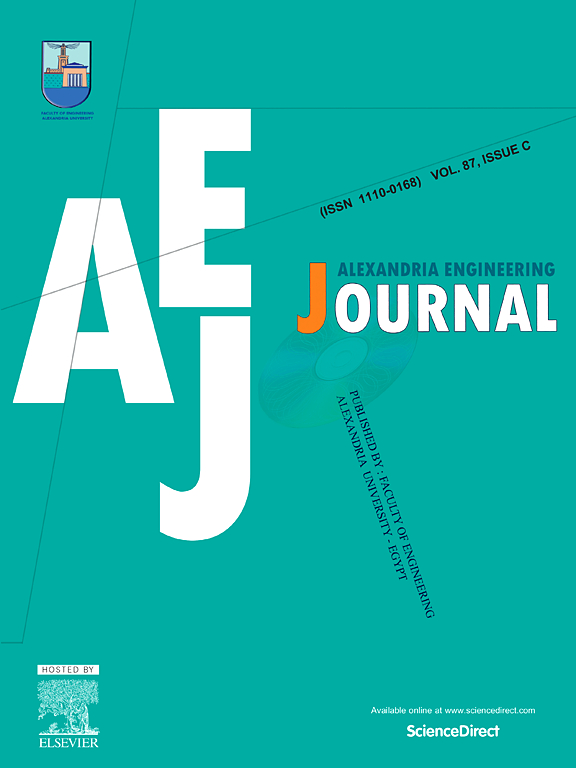A phase factor generation using RNNs deep learning algorithm-based PTS method for PAPR reduction of beyond 5G FBMC waveform
IF 6.2
2区 工程技术
Q1 ENGINEERING, MULTIDISCIPLINARY
引用次数: 0
Abstract
Filter Bank Multicarrier (FBMC) is considered one of the strong applicants for a radio system beyond the fifth generation (B5G) that improves spectral access and lowers interference. It utilizes a prototype filter for each sub-carrier, making it best for the beyond fifth generation (B5G) framework. The performance of the FBMC is hugely impacted by the high peak-to-average power ratio (PAPR), which lowers the effectiveness of the power amplifier (PA) used in the 5G-based FBMC waveform. The conventional partial transmission sequence (PTS) technique requires high computational complexity due to the need for multiple Inverse Fast Fourier Transforms (IFFTs) and phase optimization, which can increase processing time and system latency. This article proposes a hybrid method combining a partial transmission sequence and recurrent neural network (RNN) known as PTS-RNNs. RNNs improve the performance of the PTS by efficiently predicting optimal phase factors, reducing computational complexity, and lowering the PAPR of the FBMC waveform. The parameters such as PAPR, bit error rate (BER), and power spectral density (PSD) are estimated for 256 sub-carriers under the Rayleigh and Rician channels for FBMC and orthogonal frequency division multiplexing (OFDM). The experiment results reveal that the proposed PTS-RNNs method achieves an efficient 55.45 % and 67.56 % power saving performance for Rayleigh and Rician channels, with enhanced PSD performance while preserving the BER compared to the traditional selective mapping (SLM) and PTS methods. It is also noticeable that by adding more sub-blocks and phase parameters, PAPR can be further optimised.
利用基于 RNNs 深度学习算法的 PTS 方法生成相位因子,以降低超越 5G FBMC 波形的 PAPR
滤波器组多载波(FBMC)被认为是第五代以上无线电系统(B5G)的有力申请者之一,它能改善频谱接入并降低干扰。它为每个子载波使用一个原型滤波器,因此最适合超越第五代(B5G)框架。峰均功率比(PAPR)过高会严重影响 FBMC 的性能,从而降低用于基于 5G 的 FBMC 波形的功率放大器(PA)的效率。传统的部分传输序列(PTS)技术需要多次反快速傅里叶变换(IFFT)和相位优化,因此计算复杂度高,会增加处理时间和系统延迟。本文提出了一种结合部分传输序列和递归神经网络(RNN)的混合方法,称为 PTS-RNN。RNN 通过有效预测最佳相位系数、降低计算复杂度和降低 FBMC 波形的 PAPR,提高了 PTS 的性能。针对 FBMC 和正交频分复用(OFDM)的瑞利(Rayleigh)和里阡(Rician)信道,对 256 个子载波的 PAPR、误码率(BER)和功率谱密度(PSD)等参数进行了估计。实验结果表明,与传统的选择性映射(SLM)和 PTS 方法相比,所提出的 PTS-RNNs 方法在瑞利和里阡信道中分别实现了 55.45% 和 67.56% 的高效省电性能,并在保持误码率的同时增强了 PSD 性能。此外,通过增加子块和相位参数,还能进一步优化 PAPR。
本文章由计算机程序翻译,如有差异,请以英文原文为准。
求助全文
约1分钟内获得全文
求助全文
来源期刊

alexandria engineering journal
Engineering-General Engineering
CiteScore
11.20
自引率
4.40%
发文量
1015
审稿时长
43 days
期刊介绍:
Alexandria Engineering Journal is an international journal devoted to publishing high quality papers in the field of engineering and applied science. Alexandria Engineering Journal is cited in the Engineering Information Services (EIS) and the Chemical Abstracts (CA). The papers published in Alexandria Engineering Journal are grouped into five sections, according to the following classification:
• Mechanical, Production, Marine and Textile Engineering
• Electrical Engineering, Computer Science and Nuclear Engineering
• Civil and Architecture Engineering
• Chemical Engineering and Applied Sciences
• Environmental Engineering
 求助内容:
求助内容: 应助结果提醒方式:
应助结果提醒方式:


